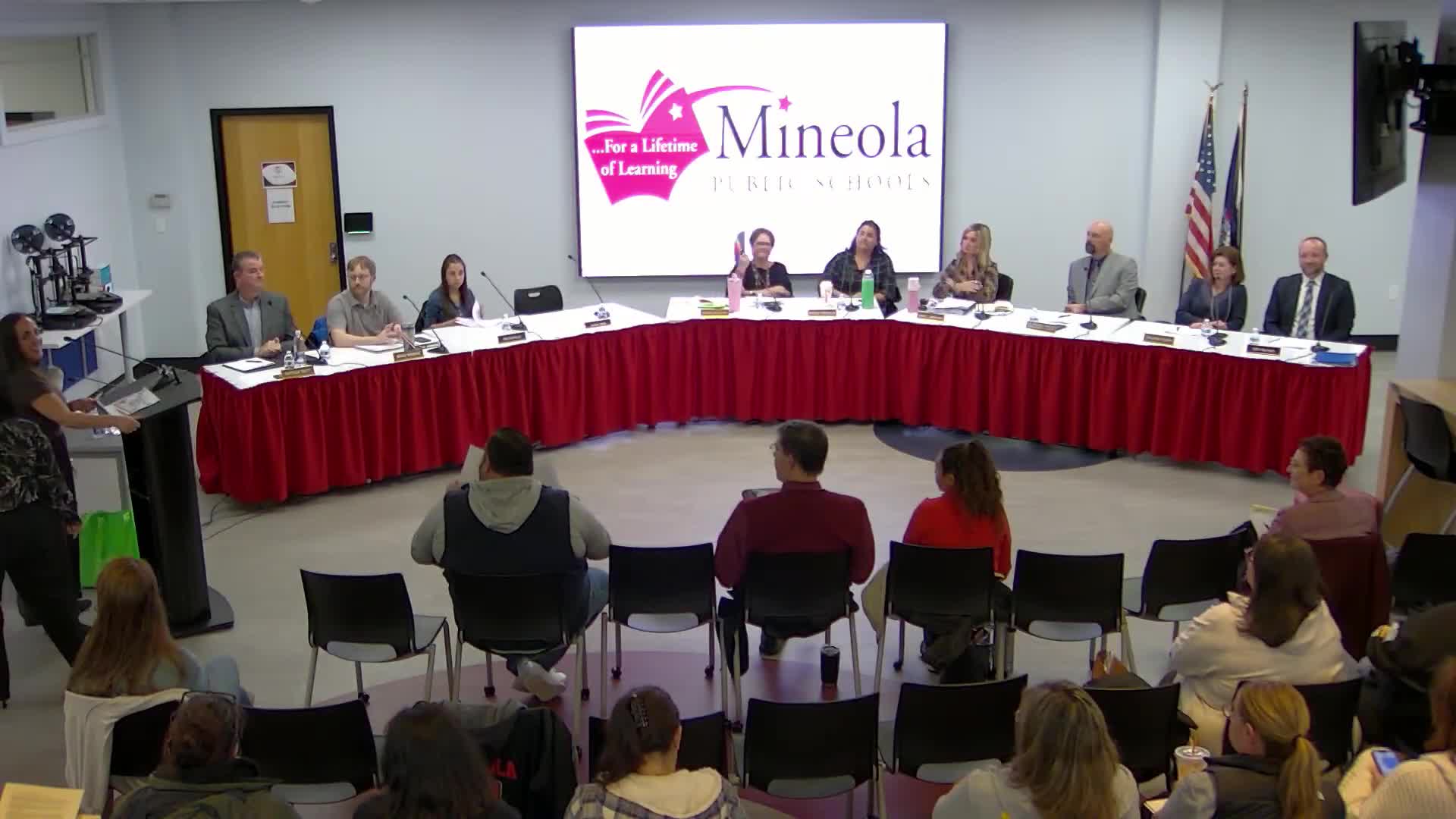Meadow Drive and Hampton Street principals detail K–2 literacy, math gains and new early‑learning initiatives
October 31, 2025 | MINEOLA UNION FREE SCHOOL DISTRICT, School Districts, New York
This article was created by AI summarizing key points discussed. AI makes mistakes, so for full details and context, please refer to the video of the full meeting. Please report any errors so we can fix them. Report an error »

Principals Jenny Fahey (Meadow Drive) and Ms. Melendez (Hampton Street) presented combined K–2 data and initiatives to the Mineola Board of Education on Oct. 30, outlining literacy and math assessment results, intervention plans and an early‑learning executive‑function program.
Fahey told trustees that the buildings use multiple assessments — MCAS for dual‑language classrooms, EasyCBM and NWEA for reading and math — and that the district triangulates results with teacher observation and Foundations phonics assessments. She said intervention thresholds are flexible but generally begin at or below the 25th percentile with tiered responses: in‑class supports, reading interventionist push‑in (tier 2) and small pull‑out interventions (tier 3) using programs such as Fun and Focus, Spire and Sound Sensible when progress monitoring indicates slower gains.
The principals showed that, by the measures cited, 68% of kindergarteners, 63% of first‑graders and 65% of second‑graders were at or above grade level on reading NWEA metrics; a separate set of benchmark measures showed similar strengths in phonemic awareness, passage fluency and comprehension. Fahey emphasized that badge data (classroom mastery badges) correlated with NWEA results and are being used to target instruction.
The presentation also described dual‑language alignment efforts (both languages used with integrity; aligned vocabulary and classroom resources), a buddy program that pairs general‑education first graders with RISE students for supervised interactions, and the district’s newly developed "Mini Mustangs" curriculum to teach age‑appropriate executive‑function skills (emotional control, cognitive flexibility, working memory and response inhibition) in pre‑K–2 classrooms.
Why it matters: Principals said the combined data and new curricular work are intended to close early learning gaps, build writing and math fluency, and provide consistent supports across the two geographically separate buildings. Trustees and speakers praised the collaboration and emphasized pre‑K as an effective investment; trustees asked for historical benchmarks to show long‑term impact of universal pre‑K.
Next steps: Principals said teacher professional learning will continue, units will be refined based on teacher feedback and the district will continue sharing historical and assessment data during articulations with Jackson Avenue (the next grade level) to ensure continuity of supports.
Fahey told trustees that the buildings use multiple assessments — MCAS for dual‑language classrooms, EasyCBM and NWEA for reading and math — and that the district triangulates results with teacher observation and Foundations phonics assessments. She said intervention thresholds are flexible but generally begin at or below the 25th percentile with tiered responses: in‑class supports, reading interventionist push‑in (tier 2) and small pull‑out interventions (tier 3) using programs such as Fun and Focus, Spire and Sound Sensible when progress monitoring indicates slower gains.
The principals showed that, by the measures cited, 68% of kindergarteners, 63% of first‑graders and 65% of second‑graders were at or above grade level on reading NWEA metrics; a separate set of benchmark measures showed similar strengths in phonemic awareness, passage fluency and comprehension. Fahey emphasized that badge data (classroom mastery badges) correlated with NWEA results and are being used to target instruction.
The presentation also described dual‑language alignment efforts (both languages used with integrity; aligned vocabulary and classroom resources), a buddy program that pairs general‑education first graders with RISE students for supervised interactions, and the district’s newly developed "Mini Mustangs" curriculum to teach age‑appropriate executive‑function skills (emotional control, cognitive flexibility, working memory and response inhibition) in pre‑K–2 classrooms.
Why it matters: Principals said the combined data and new curricular work are intended to close early learning gaps, build writing and math fluency, and provide consistent supports across the two geographically separate buildings. Trustees and speakers praised the collaboration and emphasized pre‑K as an effective investment; trustees asked for historical benchmarks to show long‑term impact of universal pre‑K.
Next steps: Principals said teacher professional learning will continue, units will be refined based on teacher feedback and the district will continue sharing historical and assessment data during articulations with Jackson Avenue (the next grade level) to ensure continuity of supports.
View the Full Meeting & All Its Details
This article offers just a summary. Unlock complete video, transcripts, and insights as a Founder Member.
✓
Watch full, unedited meeting videos
✓
Search every word spoken in unlimited transcripts
✓
AI summaries & real-time alerts (all government levels)
✓
Permanent access to expanding government content
30-day money-back guarantee

